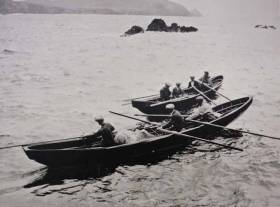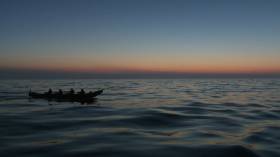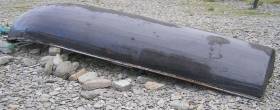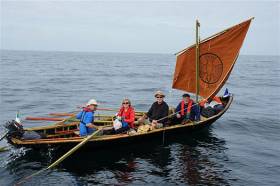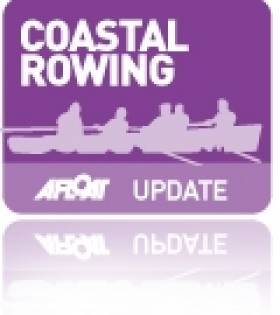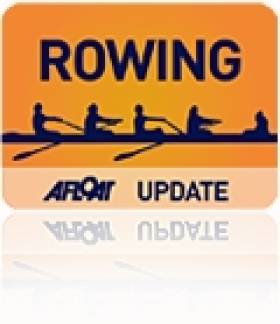Displaying items by tag: Currach
History of Irish Curach in Irish is Unique Publication
There’s something about the magnificent West Coast of Ireland that produces larger-than-life characters of prodigious energy writes W M Nixon. And James Cahill of Mayo is one of them. Way back in 1974, he sailed round Ireland in a 13ft 6ins clinker-built open sailing dinghy, sometimes with a friend as crew, sometimes single-handed. Whatever about the size or otherwise of the ship’s complement, it was all done without any support vessel whatever.
Then he got the idea of the Atlantic triangle cruise, so he built himself a handsome and hefty steel cruiser for the project, and he did it. And by the time he returned, there was a Cahill family in the making, so he settled back again on the shores of Clew Bay, and buckled down to domesticity and work.
But with that extra Cahill energy, he also found the time and space for other things. Thus when he had ascertained that there are thirteen different identifiable types of traditional skinned-hull curachs to be found in Ireland (he spells it with just the one “r”), he set to and built one of each himself, to be preserved for us all in his own private collection of thirteen curachs.
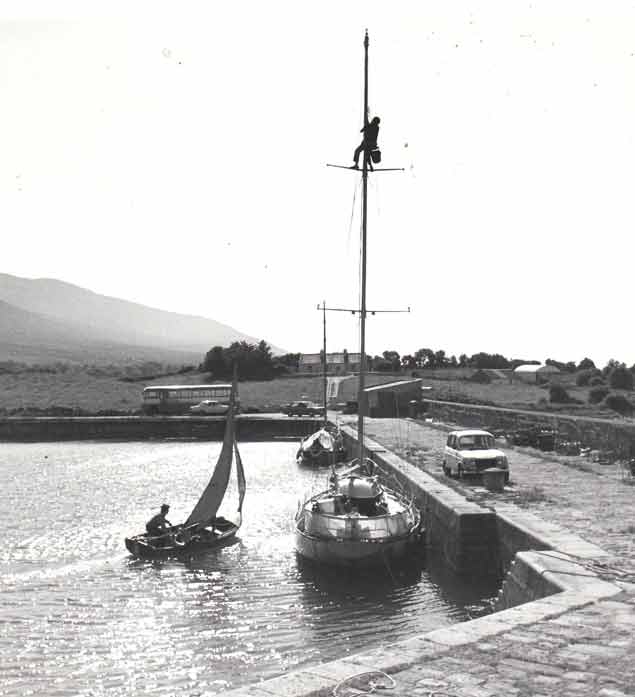
So although he now also has something of a flotilla of larger more modern craft, the curachs have always had a special place in his heart. And when he heard that a book of the complete story of the curach had been written by the former Principal of the Sligo Institute of Technology Dr Brendan Caulfield – and in Irish too, which is very rare for a maritime book – he decided the world should know more about it, so he forwarded us a copy, and obligingly included a review-cum-guide in Irish and English by Dr Caulfield’s son Oisin.
We’ll let Oisin’s review speak for itself, as he makes some unexpected points of special interest. Bur we can’t let it go that Dr Caulfield assesses that there are fourteen different identifiable Irish curach types, which is good news for those of us who might incline to be superstitious about James Cahill’s reckoning of thirteen.

Curaigh na hÉireann – a stair agus a scéal.
Breandán Mac Conamhna
Foilsitheoir Cló Iar Chonnachta
Is stair mhuirí chósta iarthair na hÉireann í an saothar tábhachtach seo, scríofa i nGaeilge, a fhiosraíonn an pháirt láirneach atá ag an gcurach in oidhreacht mhuirí na hÉireann. Is iar-stiúirtheoir é an t-údar ar IT Shligigh, a chaith roinnt maith bliana ar an staidéar seo, agus leabhar eile foilsithe aige cheana fhéin faoin gcurach óna áit dhúchais fhéin ar chósta thuaidh Mhaigh Eo.
Ríomhann an leabhar stair an churaigh, ó na tagairtí clasaiceacha agus ó na hAnnála is luaithe, tríd na himmrámha agus faoi “impireacht an churaigh” timpeall an Mhuir Éireann le linn na Ré Dorcha, go dtí forbairt an churaigh traidisiúnta san naoú haois déag. Déanann sé cur síos ar a thábhacht mar an príomhshoitheach iascaireachta ar feadh breis agus céad bliain, agus leanann sé a fhorbairt agus a áit i bpobal chósta an iarthair go dtí an lá atá inniu ann.
In éacht suntasach de scoláireacht nua, cuireann sé béim ar an bpáirt riachtanach a ghlac oifigí fórsaí armtha na Breatainne i fhorbairt an churaigh traidisiúnta, ag cur na teicnící agus ábhair na Réabhlóide Tionsclaíochta i bhfeidhm ar dhearadh Nua Aoise na gCloch, de chiseán caoladóireacht clúdaithe le seithí. Go háirithe, léiríonn sé gurb é an Ginearál Affleck a bhí freagrach as garmain sáfa agus tairní iarann a thabhairt isteach; agus do cheap Lieutenant Traxton den Chabhlach Ríoga ar an gclúdach canbhás tarráilte. Bhí an nuálaíocht seo thar a bheith tábhachtach, mar gheall ar a thoradh eacnamaíochta; ina dhiaidh, bhí na teaghlaigh bhochta ar chósta an iarthair abálta líon a shaothrú chun clúdach an churaigh a thóigeáil, in áit an praghas ró-ard a n-íoc ná aon bheitheach a bhí acu a mharú chun a sheithe a fháil. Teasbánann an t-údar – trí léiriú mionsonraithe ar an gcomhchoibhneas atá ann idir na chineál curaigh atá ann leis na rannóga stairiúla de Gharda Chósta na Breatainne – go raibh an Gharda Chósta freagrach as an dearadh nua a scaipeadh agus a chur chun cinn ar fud an chósta, i gcúnamh mór do na pobail bochta. Leanann sé scaipeadh an churaigh nua trí anailís ar an athrú a tháinig ar an mheáinchriú de réir rannóga an Gharda Chósta, foinsithe ó na tuairiscí iascaireachta agus ón Gharda Chósta ón naoú haois déag.
Sa dara chuid den leabhar, tá suirbhé iomlán de gach saghas de churaigh atá ann inniu, agus curachán na Bóinne chomh maith, le saibhreas mór de stair mhuirí agus sóisialta, léirithe i ngach áit le grianghraif stairiúla. Tá téarmaíocht áitiúil a mbaineann leis an gcurach bailithe ag an údar ar a thaisteal go gach port an churaigh ar chósta an iarthair, agus tá taifead déanta aige de i ngach caibidil. Críochnaíonn an leabhar le cúpla aguisín, le pleananna mionsonraithe de gach saghas de churaigh, agus treoir praiticiúil chun curach a thóigeáil.
Ba chóir don leabhar seo a bheith I leabharlann gach duine a bhfuil suim acu i stair mhuirí na hÉireann. Mar gheall ar an saibhreas atá sna foclóirí de téarmaíocht áitiúil nach bhfuil ar fail in aon áit eile, bheadh suim ag scoláirí na Gaeilge ann chomh maith.
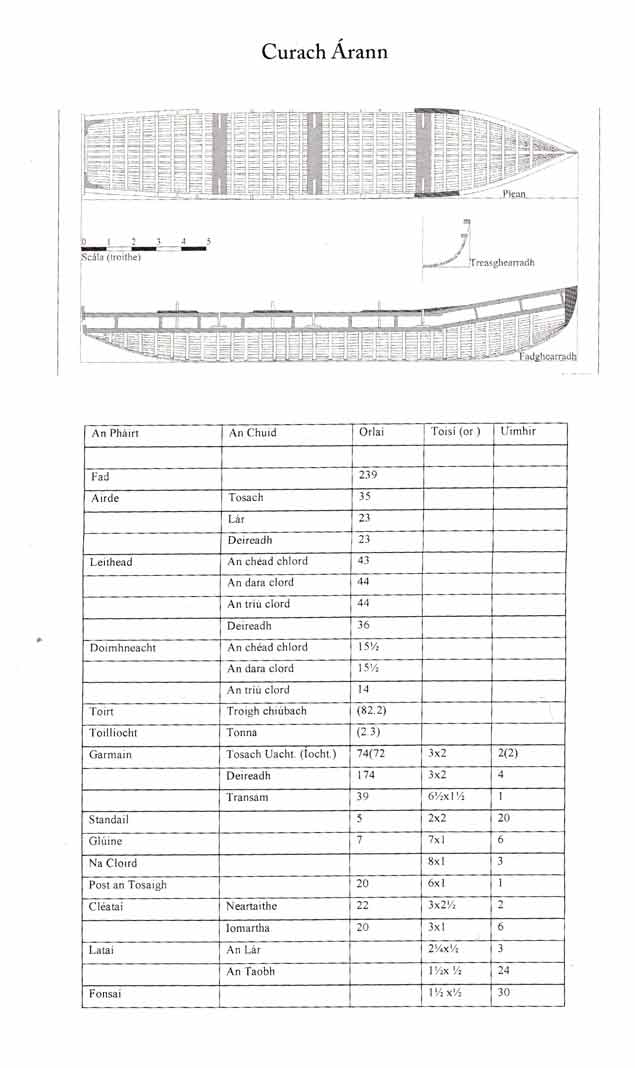
This important book is a maritime history of the west coast of Ireland, written in the Irish language, which explores the central role played by the curach in Ireland’s maritime heritage. The author, a former director of IT Sligo, has devoted many years to this study, having already published a book on the curach on the north Mayo coast, where he was born.
The book traces the history of the curach, from the earliest classical and annalistic records, through the immrámha and the Dark Age “empire of the curach” around the Irish Sea, to the development of the traditional curach in the nineteenth century. It explores its importance as the primary fishing craft on the west coast for over a century, and follows its development and its place in coastal communities to the present day.
In a significant contribution of original scholarship, it highlights the central role played by officers of the British armed forces in the development of the traditional curach, in applying the techniques and materials of the industrial revolution to the Neolithic design of a hide-covered wicker basket. In particular, it shows how General Affleck was responsible for introducing sawn gunwales and iron nails, and how Lieutenant Traxton of the Royal Navy was responsible for the introduction of a tarred canvas cover.
Before that, valuable animal skins had to be used. This crucial innovation, which had far-reaching economic consequences, meant that impoverished families of the western seaboard could grow flax to make linen which was then tarred when the boat was covered, rather than being faced with the prohibitive expense of slaughtering whatever livestock they possessed for their hides.
The author proceeds to show – by a detailed demonstration of the correlation of extant curach types with historical UK coastguard districts – how the coastguard was responsible for the introduction and promotion of the new curach design along the western seaboard, in a material contribution to the well-being of its disadvantaged communities. The propagation of the new design is traced by an analysis of the change in average crew size by coastguard district, sourced from nineteenth century fisheries reports.
The second part of the book consists of a comprehensive survey of all the extant curach types, as well as the Boyne coracle, supplemented by a wealth of maritime and social history, illustrated throughout with historical images. Local Irish words of curach terminology, sourced by the author in his travels through all the curach ports of the west coast, are recorded in each chapter.
The book concludes with a set of appendices, containing detailed plans of every curach type, and practical instructions for building a curach. This book deserves a place on the shelves of everyone with an interest in Irish maritime history. Because of its wealth of local vocabulary which is unrecorded anywhere else, it will also be of interest to scholars of the Irish language.
Irish Premiere For ‘The Camino Voyage’ Last Weekend
#CaminoVoyage - Saturday night (10 March) saw the Irish premiere of The Camino Voyage as part of the Audi Dublin International Film Festival 2018.
The documentary follows a motley crew including a writer, an artist a stonemason and two musicians — including Oscar-winner Glen Hansard — as they embarked on a 2,500km odyssey by currach from Ireland to northern Spain, following the trail of the Camino de Santiago.
The 2016 adventure in the Naomhóig na Tinte was previously broadcast on TG4 and covered on Afloat.ie by our own Winkie Nixon, but this past weekend marked the first time the international feature-length version had been shown on the big screen in Ireland.
Crew members Brendan Moriarty, Brendan Begley and Liam Holden were in attendance with director Dónal Ó Ceilleachair at the Irish Film Institute on Saturday for the screening, which also served as a tribute to fellow crew Danny Sheehy (Domhnall Mac Síthigh), who died in 2017 while sailing the Naomhóg south to Portugal.
Celebrating the Irish Premiere of The Camino Voyage @IFI_Dub on Saturday night with Brendan Moriarty (left), Dónal OCeilleachair (director), Breanndán O Beaglaoich and Liam Holden. Photo by Simon Lazewski. #ADIFF18 pic.twitter.com/dyZJJlnlHP
— Dublin Film Festival (@DublinFilmFest) March 12, 2018
The Camino Voyage will have its next Irish screening as the opening film of the Dingle International Film Festival next week on Thursday 22 March, and can be seen in Westport on 13 April as part of the Celtic Camino Festival.
#Currach - The first of four new community-built currachs launches from Inishbofin this afternoon (Sunday 30 April), as Galway Bay FM reports.
Young people from the Connemara island have been heavily involved in the traditional boat-building project, funded via the Coca-Cola Thank You Fund for voluntary groups.
And they will see the fruit of their hard work take to the water from the Old Pier at 1pm today, coinciding with the final day of this year’s Inishbofin Arts Festival.
Kerry Currach Voyaging On The Santiago Camino Features on TG4
The remarkable “voyages as pilgrimages” of a Kerry naomhog (currach) have been followed with fascination by an increasing number of maritime enthusiasts ever since the founding crew of Breandan Begley, Anne Bourke, Danny Sheehy and Liam Holden rowed, sailed and very occasionally outboard-motored the little vessel the whole way from southwest Ireland to the holy island of Iona in Scotland four year ago writes W M Nixon.
They brought with them the gift of a translation of the bible in Irish – a publication which apparently had been lacking in the Iona library.
For most sailors, that direct delivery would have been quite enough for one year. But in fact when the naomhog finally returned to Kerry, she’d completed a voyage round Ireland, having returned via the east and south coasts.
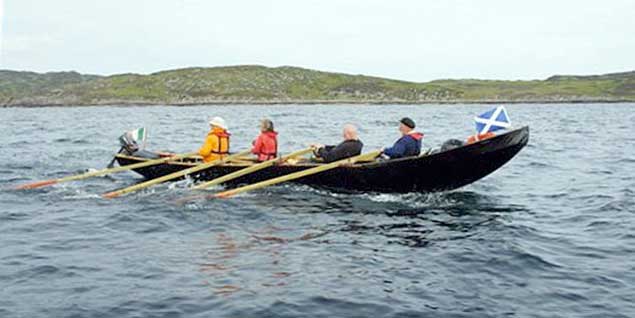 It wasn’t all easy sailing by any means. Much of the voyage to Iona and back round Ireland was achieved by muscle power. Photo Mark Tierney
It wasn’t all easy sailing by any means. Much of the voyage to Iona and back round Ireland was achieved by muscle power. Photo Mark Tierney
Once this was achieved, the idea of undertaking the ultimate European Atlantic seaboard pilgrimage voyage – from Ireland to Santiago Compostela in northwest Spain under sail and oar only – began to take shape, and last summer they completed it after two stages. They were accompanied by Paddy Barry’s 45ft cruiser Ar Seachran as mothership, though the little vessel made the long hops – with an overwinter in Brittany – entirely under her own steam.
In classic Camino style, it has been a picaresque venture, with some crew changes and new folk met at different times. Everyone involved has a strong association with Irish music, and by the time they got to Santiago their crew included Oscar-winning Dublin musician Glen Hansard, moving one of his shimates to comment that “having Glen Hansard rowing at sea was like bringing Shergar to plough a field”.
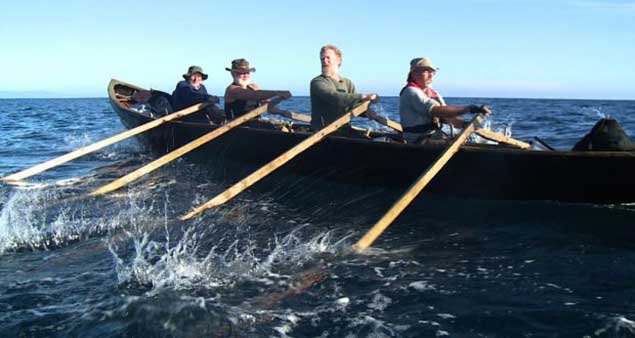 Getting your shoulders into it – Glen Hansard (second right) doing his bit off the coast of Spain
Getting your shoulders into it – Glen Hansard (second right) doing his bit off the coast of Spain
Happily for the rest of us, a three-part TG4 series has been made on the entire venture, and the first part airs this Sunday (February 19th) at 8.30pm, while for those who miss that particular bus, there’s a repeat on Monday February 20th at 7.30pm, with the same programming being continued for the next two weekends. Check out the weblink here
As for Paddy Barry, his extraordinary lifetime of combining cruising to remote regions with some very challenging mountaineering has been encapsulated in a live show, Sailing to Mountains & Other Cold Places, which he’ll be giving to the Irish Mountaineering Club at the Teachers’ Club, Parnell Square, Dublin 1 on Thursday, February 23rd February, and in the Maritime Museum in Dun Laoghaire on Thursday April 20th.
Meanwhile his own seafaring plans are undergoing change, as he has returned to his roots with the acquisition of a 27ft Galway Hooker gleotoig in Connemara, while his alloy-built Frers 45 Ar Seachran, a veteran of international Two Ton racing which he then very successfully used for high latitude voyaging, is now on the market.
 Paddy Barry’s Frers 45 Ar Seachran at Poolbeg in Dublin after returning from a voyage to Greenland. Photo Tony Brown
Paddy Barry’s Frers 45 Ar Seachran at Poolbeg in Dublin after returning from a voyage to Greenland. Photo Tony Brown
Although this year's 38th Galway Hooker racing at Cruinniú na mBád was cut short due to the high winds there was still plenty of activity at Galway's maritime sailing festival.
'Aisling Geal', Bob Quinn's original 1979 film of the first Cruinniu festival, got an airing on Sunday in the Courthouse and festival goers got a glimpse of how it all began.
This historic boat, Galway Hooker Festival, which has been held in Kinvara each year since '79, celebrates the village's heritage of using turf boats to transport turf from Connemara to south Galway and north Clare.
Crinniu na mBad Currach Race results
Men's and Women's Race
1st Niamh Folan & Jason Folan
2nd Bernie Joyce & Joe Joyce
3rd Nora McDonagh & Michael Folan
4th Georgina Folan & Michael Mulkerins
Junior Race
1st Charlotte Hannon, Bronagh Brennon & Mary McCarthy
2nd Tim Hannon, Georgina Folan & Hayley Folan
Three Men's Final
1st Joe Joyce, Martin Mulkerins & Micheal Mulkerins
2nd John Joe Donoghue, Seanin Honan & Padraig Canavan
Three Ladies Final
1st Leah O'Sullivan, Trish Ward & Annie Lee
2nd Máire Bríd Breathnach, Nora McDonagh & Georgina Folan
3rd Charlotte Hannon, Bronagh Breannan & Mary McCarthy
Currachs to Race in the Heart of the Capital Tomorrow
#COASTAL ROWING: The third annual Dublin Currach Regatta will take place on Saturday, the 4th of July, between the iconic bridges and in the heart of the city on the river Liffey.
Sponsored by Dublin Port Company and Dublin City Council, this is the third year that the east coast has the privilege of hosting a currach regatta included in the national currach racing league. This year the annual Dublin currach regatta will take place for the first time ever on the river Liffey in the heart of Dublin city centre.
Following many years of forging contacts between east coast currach rowers and teams on the west coast of Ireland, this is the first year that the western teams will come to Dublin to compete in a championship fixture.
Currach racing teams from Donegal, Kerry, West Clare, The Aran Islands, Connemara and Galway will attend. Both women’s and men’s crews will be competing as well as the traditional mixed crew race, Fear agus Ban. The races will feature qualifying heats following on to senior men’s and women’s finals as well as mixed crew racing.
All races will take place between 11:00 a.m. and 16:30 and the heats and competition can be viewed all along the Liffey quays right up to the Jeanie Johnston for the duration of the regatta.
2015 Ocean to City – An Rás Mór Prizewinners
#oceantocity – Cork harbour waters featured a flotilla of over 180 Irish and international boats taking part in the Ocean to City, An Rás Mór on Saturday. A record number of boats competed in the race which saw competitors row 28km from Crosshaven's Royal Cork Yacht Club to Lapps Quay.
Blackrock Youth Course
1st Lassies Crew Tara & Pamela, The Pink Pirates, YAP Ireland
1st Lads Crew Adam & Jake, Mooju, TACT Project, Togher
1st Youth Crew William & Charlie, The Red Oars, Life Centre
1st Junior Kayak Daniel Redmond, Phoenix Kayak Club
1st Cooperation Ireland Crew David & Jack, Belfast/Lisburn
Ogra Cup Winner Mikey & Niall, The Daisy, Foroige Greenmount/Ballyphehane
Most Fiercesome Youth Crew Jack, Ciaran & Cliona, Belfast/ Lisburn Cooperation Ireland
Monkstown-Kayak Course
1st Woman Kayak #770 Catherine Molloy
3rd Veteran Kayak #753 Barry Marron, Inniscara Sailing & Kayaking Club
2nd Veteran Kayak #766 Sean Casey
1st Veteran Kayak #773 Patrick Sparrow
2nd Single Sit-on-top Kayak #753 Barry Marron, Inniscara Sailing & Kayaking Club
1st Single Sit-on-top Kayak #669 Chris Coady
3rd Single Touring Kayak #770 Catherine Molloy
2nd Single Touring Kayak #766 Sean Casey
1st Single Touring Kayak #773 Patrick Sparrow
Monkstown Course
1st 2-hand Currach #105 Churchfield Community Trust, An Dobharchú
Dragon Boat Course
2nd Dragon Boat #83 Dublin Vikings
1st Dragon Boat #84 Croí Cróga
City-Kayak Course
3rd Veteran Kayak #679 Lawrence Buckley, Blackrock Surfski Club
2nd Veteran Kayak #675 Tim Healy
1st Veteran Kayak #682 Malcolm Banks, Salmon Leap
1st Veteran Woman Kayak #648 Jan Albin, Snowdonia Canoe Club (Wales)
2nd Woman Kayak #606 Ruth McAuliffe, Phoenix Kayak Club
1st Woman Kayak #648 Jan Albin, Snowdonia Canoe Club (Wales)
1st Double Kayak #509 Patrick Pierce & Ruth Phelan
3rd Touring Kayak #654 Chris McDaid, North Mayo Sea Kayakers
2nd Touring Kayak #672 Edward Doody
1st Touring Kayak #675 Tim Healy
2nd Racing Kayak #679 Lawrence Buckley, Blackrock Surfski Club
1st Racing Kayak #682 Malcolm Banks, Salmon Leap
1st Single Kayak #682 Malcolm Banks, Salmon Leap
City Course
1st Veteran Crew #17 North Berwick Rowing Club, Speedwell (Scotland)
1st City Crew #17 North Berwick Rowing Club, Speedwell (Scotland)
Ocean-Relay Course
1st Traditional-style Relay Crew #2 Kilbrin Rowing Club, Cul Rowings
1st Relay Crew #59 Galley Flash Rowing Club
1st ICRF Relay #59 Galley Flash Rowing Club
Ocean Course
2nd Mixed Crew #39 North Berwick Rowing Club, Bass Rockets (Scotland)
1st Mixed Crew #62 Edermine Ferry, Still Mad For It
1st Veteran Crew #7 Naomhóga Chorcaí, Croi Na Nog
3rd Women's Crew #51 MYC Rowing Porthmadog, Porthmadog Ladies (Wales)
2nd Women's Crew #20 St.Kearns Rowing Club, Flaming Rowing Tigers
1st Women's Crew #8 Naomhóga Chorcaí, Neart na mBan
1st Single Sliding Seat Boat #13 Mersea Island Rowing Club, Lone Wolf (England)
2nd St Ayles Skiff #39 North Berwick Rowing Club, Bass Rockets (Scotland)
1st St Ayles Skiff #38 Coigach Rowing, Coigach (Wales)
1st 4-oared Wooden Boat #20 St.Kearns Rowing Club, Flaming Rowing Tigers
1st 6-oared Wooden Boat #72 Falmouth Gig Club, Kernow Bys Vyken (England)
1st Wooden Boat #38 Coigach Rowing, Coigach (Wales)
1st Mixed Crew Celtic Longboat #54 Aberystwyth RC, Aberystwyth Mixed (Wales)
2nd Celtic Longboat #52 Aberystwyth RC, Aberystwyth Men (Wales)
1st Celtic Longboat #53 Aberystwyth RC, Aberystwyth Vets (Wales)
2nd ICRF #68 Templenoe Rowing Club
1st ICRF #63 Arklow Rowing Club, Honey Badgers
1st GRP Crew #63 Arklow Rowing Club, Honey Badgers
2nd Racing Currach #29 An Spideil
1st Racing Currach #30 Doonbeg Currach Club
1st Working Noamhóg #7 Naomhóga Chorcaí, Croi Na Nog
1st Currach #3 Naomhóga Chorcaí, Fiolair na Mara
1st Ocean Crew #3 Naomhóga Chorcaí, Fiolair na Mara
Special Awards
Meitheal Mara Challenge #105 Churchfield Community Trust, An Dobharchú
Boat of the Day, Charlie Hennessy Cup #4 Avonmore II, Paul Tingle
Boat Builder of the Day #33 Jeremy Duffin, Strangfjǫrðr, Strangford Costal Rowing Club
Community Boat Build Prize #1&2 Kilbrin Rowing Club
First International Crew #53 Aberystwyth RC, Aberystwyth Vets (Wales)
Special Endeavour Award #754 Jason Coniry for the ''First ever SUP entry''
Cian Ó Sé Commemorative Trophy #11 Naomhóga Chorcaí, Cumhacht Ceithre Capall
#currach – The Ballina Quay Regatta fest is making a fantastic return to the quay from June 12th -14th and is set to reignite the nostalgia of years gone by with a spectacular line up featuring All Ireland Currach Racing, boat treasure hunts, fishing competitions, air displays, water skiing and much much more.
The event aims to be a fantastic addition to the already action packed summer calendar in Mayo North and is being presented by the Moy Estuary Boat club, supporting the Ballyglass Lifeboat RNLI service.
After 20 years, the regatta is finally making its grand return and will delight both visitors and locals with an array of magnificient events. Friday night will see a Pirate Treasure Hunt come to the quay, followed by the Rejoice Gospel Choir Concert and the Monarch of the Quay Disco; a perfect introduction to the weekend long entertainment.
The Wild Atlantic Way Discovery Point will host a super adventurous and enjoyable day on Saturday as the Quay will be awash with activity and craic. Stand Up Paddling Board and Kayak races will be taking place all day and there will also be a Fishing Competition in the lead up to the Ceili Mor which will have the entire crowd dancing and jigging as nightime approaches.
On Sunday 14th June, local resident, 92 years young Una Timoney, will cut the ribbon and Mr Chris Reynolds, Director Irish Coast Guard will also officiate at the opening ceremony. This will be followed by Children's Pirate Themed Fancy Dress Parade to the Quay. The Band 2 Brigade will headline on Sunday with an amazing live performace and the final day will also feature a craft fair and a stunning air stunt display, the perfect day out for all the family.
The excitement is surely building, as many of the residents bear fond memories of days gone by and previous regatta festivals in the Quay. Without a doubt, a strong sense of nostalgia surrounds the festival with much anticipation for the return of the regatta, bigger and better than ever before. 4 Team Mixed Relay Swim to Sheaf Throwing, Tug-o-War, and lots more fun and games, the programme of events for the weekend is certainly an impressive one.
#Rowing - The second annual Dublin Currach Regatta will take place on Sunday 15 June.
Sponsored by the Dublin Port Company and Dublin City Council, the event will be hosted at the East Wall Water Sports Centre on the Tolka Estuary just off the Alfie Byrne Road in Dublin 3.
This is the second year that the East Coast has had the privilege of hosting a currach regatta included in the National Currach Racing League, an Coiste Lar Na gCurrachai.
Following the construction of two new currachs at the East Wall Water Sports Centre, and after many years of forging contacts between East Coast currach rowers and teams in the West of Ireland, this is the first year that Western rowing teams will come to Dublin to compete in a championship fixture.
Currach racing teams from Donegal, Kerry, West Clare, the Aran Islands, Connemara and Galway will be in attendance, bringing their own boats from as far west from Inis Óirr to compete on the day.
The race day schedule will feature qualifying heats followed by the senior men’s and women’s finals, as well as under 18s racing.
All races will take place between 11.30am and 5.30pm and can be viewed from the vantage point of the East Wall Water Sports centre as well as along the Clontarf Road.
For more details contact David Kelly on 087 961 2803 or visit www.dublincurrach.com.
Rowers Set Out To Follow 'Camino' Route By Currach
#Rowing - The Irish Independent reports on four intrepid coastal rowers who plan to follow the famous Camino pilgrimage route in a traditional currach.
Danny Sheehy, Liam Holden, Breandan O Beaglaoich and Breandan O Muircheartaigh set out from St James' Gate on the Naomh Gobnait this week, rowing out of the Liffey through Dublin Bay and down the east coast towars the Celtic Sea.
From there the four men aim for the south of England, onwards to France and around the Bay of Biscay, parallel to the renowned pilgrims' path leading to Santiago de Compostela in north-west Spain.
But such a gruelling challenge can't be completed in one go, and the wise quartet will take on the route in sections over three years - planning to complete their first stage, to Brittany, by 30 June.
Even then it will require a Herculean effort with non-stop 15-hour days in the currach, and typically unpredictable conditions at sea.
Independent.ie has more on the story HERE.




























